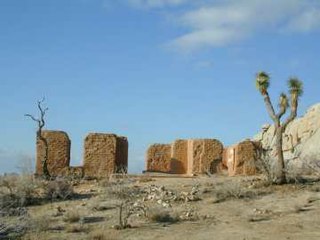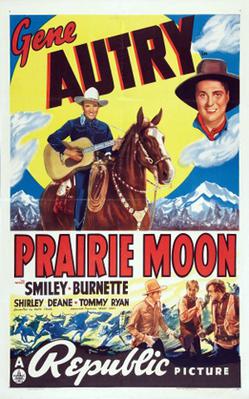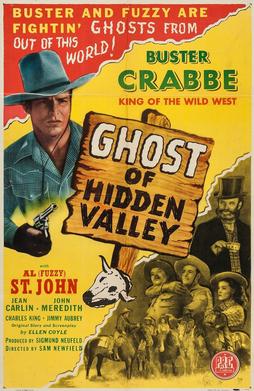Brown's Park or Browns Park, originally called Brown's Hole, is an isolated mountain valley along the Green River in Moffat County, Colorado and Daggett County, Utah in the United States. The valley begins in far eastern Utah, approximately 25 miles (40 km) downstream from Flaming Gorge Dam, and follows the river downstream into Colorado, ending at the Gates of Lodore in Dinosaur National Monument. Known as a haven for outlaws such as Butch Cassidy and Tom Horn during the late 19th century and the early 20th century, it is now the location of the Browns Park National Wildlife Refuge. It was also the birthplace of Ann Bassett. She and her sister, Josie Bassett, were considered female outlaws and girlfriends to several of Cassidy's Wild Bunch gang. It is the location of John Jarvie Historic Ranch, where, in 1880, Scotsman John Jarvie built a ranch along the Green River.

Ghost Ranch is a 21,000-acre (85 km2) retreat and education center located close to the village of Abiquiú in Rio Arriba County in north central New Mexico, United States. It was the home and studio of Georgia O'Keeffe, as well as the subject of many of her paintings.

Newman Haynes Clanton, also known as "Old Man" Clanton, was a cattle rancher and father of four sons, one of whom was killed during the Gunfight at the O.K. Corral. Two of his sons were involved in multiple conflicts in Cochise County, Arizona Territory including stagecoach robbery and cattle rustling. His son, Ike Clanton, was identified by one witness as a participant in the murder of Morgan Earp. Billy Clanton and Ike were both present at the Gunfight at the O.K. Corral in which Billy was killed. "Old Man" Clanton was reportedly involved with stealing cattle from Mexican ranchers and re-selling them in the United States. Records indicate he participated in the Skeleton Canyon Massacre of Mexican smugglers. In retaliation, Mexican Rurales are reported to have ambushed and killed him and a crew of Cowboys in the Guadalupe Canyon Massacre.

Commodore Perry Owens was an American lawman and gunfighter of the Old West. One of his many exploits was the Owens-Blevins Shootout in Arizona Territory during the Pleasant Valley War.

Ann Bassett, also known as Queen Ann Bassett, was a prominent female rancher of the Old West, and with her sister Josie Bassett, was an associate of outlaws, particularly Butch Cassidy's Wild Bunch.

George Washington Coe (1856–1941) was an Old West cowboy and a gunman during the Lincoln County War.
The Mason County War, sometimes called the Hoodoo War in reference to masked members of a vigilance committee, was a period of lawlessness ignited by a "tidal wave of rustling" in Mason County, Texas in 1875 and 1876. The violence entailed a series of mob lynchings and retaliatory murders involving multiple posses and law enforcement factions, including the Texas Rangers. The conflict took the lives of at least 12 men and resulted in a climate of bitter "national prejudice" against local German-American residents in the following years.

Joshua Tree National Park is an American national park in southeastern California, east of San Bernardino and Los Angeles and north of Palm Springs. It is named after the Joshua trees native to the Mojave Desert. Originally declared a national monument in 1936, Joshua Tree was redesignated as a national park in 1994 when the U.S. Congress passed the California Desert Protection Act. Encompassing a total of 795,156 acres – slightly larger than the state of Rhode Island – the park includes 429,690 acres of designated wilderness. Straddling San Bernardino and Riverside Counties, the park includes parts of two deserts, each an ecosystem whose characteristics are determined primarily by elevation: the higher Mojave Desert and the lower Colorado Desert. The Little San Bernardino Mountains traverse the southwest edge of the park.

The Desert Queen Mine in the Colorado Desert was one of the more long-lived gold mines of Southern California's high desert region. The abandoned mine is located in Riverside County, California within the boundaries of the Joshua Tree National Park and is included on the National Register of Historic Places. A hiking trail leads to the mine.

The Ryan House and Lost Horse Well are historic ruins in Joshua Tree National Park, California, United States. It was established by the family of J.D. Ryan, the later developers of the Lost Horse Mine, which became the most profitable mine in the area. The Lost Horse Well at the Ryan Ranch supplied water to the Lost Horse Mine, 3 miles (5 km) south and 750 feet (230 m), by pipeline. The popular park destination Ryan Mountain is named after him.

Cow Camp, located in Joshua Tree National Park, was associated with cattle rustling in the 1880s and 1890s. It was then later used as a line camp for cattle ranching. A stone chimney, two small dams, watering troughs and a well remain. One dam was built by local rancher and character William F. Keys.

The Keys Ranch is the prime example of early settlement in the Joshua Tree National Park area. Bill Keys was the area's leading character, and his ranch is a symbol of the resourcefulness of early settlers. The ranch is an extensive complex of small frame buildings built between 1910 and Keys' death in 1964. Keys pursued both ranching and mining to make a living in the desert.

Prairie Moon is a 1938 American Western film directed by Ralph Staub and starring Gene Autry, Smiley Burnette, and Shirley Deane. Written by Betty Burbridge and Stanley Roberts, the film is about a singing cowboy who takes care of three tough boys sent west from Chicago after their father dies and leaves them a cattle ranch.

The Power's Cabin shootout, or the Power Brothers shootout, occurred on February 10, 1918, when a posse attempted to arrest a group of miners at their cabin in the Galiuro Mountains. Four men were killed during the shootout, including three lawmen and Jeff Power, the owner of the cabin. The Power brothers, Tom and John, then escaped to Mexico with a man named Tom Sisson, but they were eventually caught after what was then the largest manhunt in the history of Arizona.

Ryan Mountain is a 5,456-foot-high (1,663 m) mountain in Joshua Tree National Park. The trail to the peak is a strenuous hike, ascending 1,050 feet (320 m) in 1.5 miles (2.4 km). Ryan Mountain is a popular attraction in the park, because it leads to panoramic views of Pinto Basin, Lost Horse Valley, Queen Valley, and Pleasant Valley. It is one of the locations in Joshua Tree that features abundant lichen populations. It is named after J.D. Ryan, a wealthy rancher and early mining operator in the park.

Frontier Outlaws is a 1944 American Western film directed by Sam Newfield shot at the Corriganville Movie Ranch. It was the second film in Producers Releasing Corporation's Billy the Kid film series where Crabbe changed his name to "Billy Carson".

Ghost of Hidden Valley is a 1946 American Western film directed by Sam Newfield and written by Ellen Coyle. The film stars Buster Crabbe, Al St. John, Jean Carlin, John Meredith, Charles King and Jimmy Aubrey. The film was released on June 5, 1946, by Producers Releasing Corporation.

The Pecos War, also known as the War of the Pecos and the Chisum War, was a range war fought by cattle baron John Chisum against neighboring small ranchers, farmers, and Native Americans from 1876-1877 along the Pecos River in New Mexico. The conflict was caused primarily by competition: Chisum believed that his livestock and other resources were being depleted upon by people he alleged to be rustlers. At the same time, Chisum was also fighting Mescalero Apaches from the nearby reservations who were said to prey on his herds.
Mary Elizabeth Bassett, commonly known as Elizabeth and Eliza Bassett, was a Wild West pioneer, cattle rancher, and cattle rustler. Born in Magnet Cove, Arkansas, and raised by her maternal grandparents, Bassett grew up in an equestrian household and community. As a young woman, she migrated west with her husband Herbert Bassett and their young daughter. Mary Eliza changed her name to Elizabeth when she moved Westward. By all accounts, Elizabeth was a strong, outdoorsy woman, and her marriage to Herb Bassett was unusually open-minded for the era. The Bassetts lived and worked according to their specific talents and interests, rather than traditional gender roles. Elizabeth ran the cattle and sheep ranch, and raised thoroughbred horses. Her husband Herb managed the agricultural operations and taught their children. When large cattle companies began to push out small cattle ranchers and homesteaders, Bassett organized other locals to fight back. Her daughters Ann and Josie Bassett became notable in their own right. Butch Cassidy and the Sundance Kid were close family friends of the Bassetts, and often stayed and worked at the ranch to "cool down" following their illegal escapades.
















